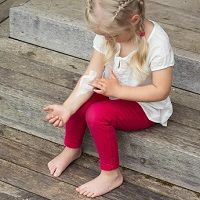Novel Topical Improves Atopic Dermatitis in Children
This most recent trial of the investigational agent E6005 follows on a previous study that evidenced benefit in adult patients.

PDE
A topical formulation of a phosphodiesterase 4 (4) inhibitor appeared to be both efficacious and well-tolerated among children with atopic dermatitis (AD), accoding to a new exploratory trial.
Osamu Nemoto, M.D., Kojinkai Sapporo Skin Clinic, Hokkaido, Japan and colleagues reported on the randomized, vehicle-controlled trial in the August issue of The Journal of Dermatology. Two strengths of the investigational agent were tested.
Nemoto and colleagues indicate that children and adults with AD are generally treated with the same agents, topical corticosteroids and calcineurin inhibitors, but acknowledged that, given the "generally more sensitive nature of pediatric skin…there is a need for a new treatment option with the long-term use of safer drugs in children with AD".
This most recent trial of the investigational agent E6005 (Eisai Co.) follows on a previous study that evidenced benefit in adult patients. A total of 62 children and adolescents were randomized to two weeks of treatment with twice daily administration of either 0.2 percent or 0.05 percent active agent, or with just the vehicle ointment.
In this exploratory assessment of efficacy, the 0.2 percent preparation, but not the 0.05 percent, separated itself significantly from the vehicle control in the investigator's global assessment. The measure of "clear" or "almost clear" for targeted eczema sites was determined for 40.6 percent with the high dose formulation compared to 25 percent with vehicle, and 34.4 percent compared to 20 percent for total application sites. There was also a significantly greater improvement in pruritus score with the 0.2 percent ointment than vehicle.
TCI
Both strengths of the active formulation were well tolerated. Nemoto and colleagues note that, in contrast to some association of transient burning sensation with topical calcineurin inhibitor (), "there were no cases of skin infections or adverse reactions, including burning sensations and skin atrophy, at the application sites."
PDE
The investigators suggest that their exploratory assessment of efficacy will be confirmed by studies with larger sample sizes and longer durations of treatment. They expect the efficacy of this 4 inhibitor will be found "comparable with the efficacy of treatment with mild TCI” and can be “one possible option as safe and effective treatment in pediatric patients with AD."